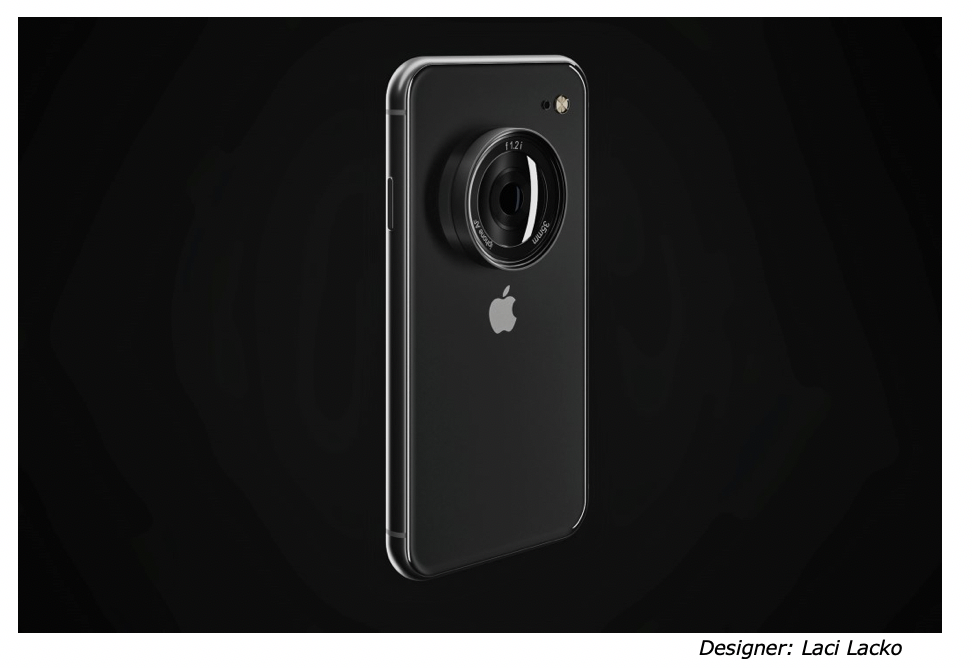Vertical Divider
Single Lens Camera on the Drawing Board for Smartphones
Instead of having 3 lenses coming together to create a computational portrait, a larger lens and sensor would turn the iPhone into a DSLR killer. DSLRs are better cameras, they’re more expensive, more versatile, more professional… but they aren’t as popular as the iPhone camera. According to studies, 1.43 trillion photos were taken in 2020 – 91% of which were through smartphones, and just 6% through digital cameras. Why doesn’t Apple and Samsung just make a bigger, better camera that is popular but also a qualitative powerhouse? This iPhone by Slovakian designer Laci Lacko shows us what a single-shooter large-lens iPhone would look like.
Figure 1: Eliminating the Camera Bump
Instead of having 3 lenses coming together to create a computational portrait, a larger lens and sensor would turn the iPhone into a DSLR killer. DSLRs are better cameras, they’re more expensive, more versatile, more professional… but they aren’t as popular as the iPhone camera. According to studies, 1.43 trillion photos were taken in 2020 – 91% of which were through smartphones, and just 6% through digital cameras. Why doesn’t Apple and Samsung just make a bigger, better camera that is popular but also a qualitative powerhouse? This iPhone by Slovakian designer Laci Lacko shows us what a single-shooter large-lens iPhone would look like.
Figure 1: Eliminating the Camera Bump
Two years ago, a phone that looked like this would be considered repulsive, but after the kind of cameras placed on newer phones (especially that whopper camera module on the Xiaomi Mi 11 Ultra), it doesn’t feel all that bad. It’s highly reminiscent of those slim point-and-shoot cameras from the 2000s. The single lens on the iPhone would end up fulfilling the role of multiple lenses. It would be much better at generating authentic bokeh during portrait mode, and a larger sensor would mean much more light entering the camera, resulting in a greater dynamic range, and better low-light performance. The iPhone could easily do all this without any computational algorithms, allowing the iPhone’s image signal processing to work on other details.
Figure 2: 35mm Lens Equivalent
Figure 2: 35mm Lens Equivalent
The lens, at least on this concept, is a 35mm shooter with an aperture of f1.4. That massive aperture would allow large amounts of light to hit the camera sensor, creating incredibly low light performance and great bokeh, but at the same time, the phone’s ability to regulate the aperture would also give it the ability to shoot crisp photos too, keeping everything in focus. The biggest disadvantage of one lens on the camera is sacrificing the wide and ultrawide shooting abilities that the current iPhones have… perhaps the only reason Apple (or no other company, for that matter) is putting all its eggs in just one basket, uh, camera. Xiaomi is reportedly working on a camera with a liquid lens (similar to the human eye) that can change in shape, allowing it to go from telephoto to macro, or even to ultrawide. This technology would essentially make extra camera lenses redundant, as the liquid lens camera would easily be able to be a jack of all trades.
Figure 3: Apple Mysterious Patent For An SLR-Style Large-Lens Camera System.
Figure 3: Apple Mysterious Patent For An SLR-Style Large-Lens Camera System.
Figure 4: Apple Single Lens Camera Rendering
|
Contact Us
|
Barry Young
|




